What is Adho Mukha Svanasana (Downward-Facing Dog Pose)?
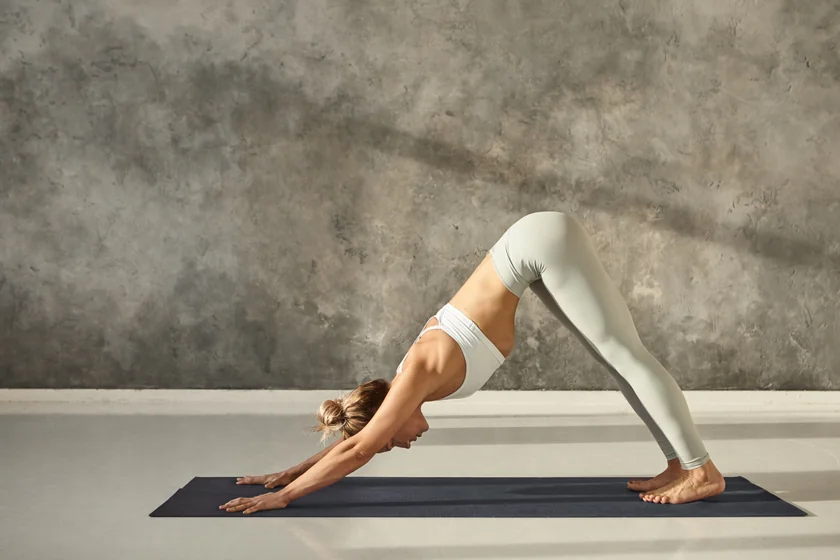
Adho Mukha Svanasana, or Downward-Facing Dog Pose, is a yoga pose resembling a dog stretching while yawning. This pose is used for lengthening and relaxing the upper body.
This beginner-friendly pose enables you to open your chest, back, tailbone, and shoulders. At the same time, this pose helps in engaging the core muscles, ankles, hamstrings, and calves. This is a yoga pose that will benefit your whole body.
Downward-Facing Dog is used twice in the Surya Namaskar sequence and it’s also used as a transitional pose in many Ashtanga, Vinyasa, and Power yoga flows.
Overview & Etymology
In Sanskrit, 'Adho' means down, 'Mukha' means face, 'Svana' means Dog, and 'Asana' means posture.
There are no traces of the Downward-Facing Dog pose in the ancient yoga texts. There is a similar posture in an eighteenth-century book, Haṭhābhyāsapaddhati (Hatha Yoga Manual), known as the Gajasana or Elephant Pose.
Today, this multi-purpose yoga asana is widely used for various purposes, like lengthening, preparing, relaxing, and transitioning between a flow, but this was not the case a few years back. Until the 1930s, Surya Namaskar was not a popular part of ancient yoga practice.
Raja Pratinidhi Pant first made this pose popular as part of the Sun Salutation in his book, The Ten-Point Way to Health: Surya Namaskars. Adho Mukha Svanasana was included in the Sun Salutation practice twice in his book.
Afterward, yoga gurus and researchers like Swami Kuvalayananda, Tirumalai Krishnamacharya, B. K. S. Iyengar, and Pattabhi Jois popularized the Sun Salutation, which also helped Downward-Facing Dog gain in popularity and become an essential part of the modern-day yoga practice.
Sanskrit Name: अधोमुखश्वानासन Pronunciation: A-doh MOO-kah shvah-NAS-anna
Pose Type: Forward Bend or Inversion
Also known as: Downward-Facing Dog Pose or Downward Dog
Strengthens: Core, Arms, Shoulders, and Ankles
Stretches: Spine, Shoulders, Hamstrings, Calves, and Traps
Health Benefits of Adho Mukha Svanasana
Reduces low back pain.
Improves body posture.
Strengthens the whole body.
Enhances mobility and agility in the spine.
Strengthens the knees, wrists, and ankle joints.
Helps relax the heart after an intense yoga flow.
Improves respiratory function and stimulates cardiac health.
Balances the throat, heart, and solar plexus chakras.
Enhances blood flow in the brain and improves its function.
When to Avoid Performing Adho Mukha Svanasana?
Avoid if you have weak retinas.
Avoid if you have heart problems.
Avoid if you have inflammatory joints.
Avoid if you recently had any surgery.
Avoid during the third pregnancy trimester.
Avoid if you are experiencing pain or a recent injury.
Avoid if you have migraines, high blood pressure, and/or epilepsy.
How to do Adho Mukha Svanasana(Downward-Facing Dog Pose)?
The practice of Downward-Facing Dog Pose is divided into four different stages:
Part 1 - Preparatory Poses for Adho Mukha Svanasana
The Downward-Facing Dog Pose is known to target your spine, core, chest, and shoulders. So it’s essential to activate these areas of your body before getting into the primary pose.
Below is the list of some yoga asanas that will help:
1. Marjaryasana (Cat Pose) - This pose will activate your spine, shoulders, core, and tailbone area. Get into a tabletop position by placing your hands and shins on the ground. Inhale, press your knees and hands firmly into the mat and engage your core muscles.

Now, exhale as you round your spine towards the ceiling, tuck your chin into your chest and focus your gaze towards your navel. Hold this for a few seconds. Now, release the post and allow your spine to return to a neutral shape.
2. Bitilasana (Cow Pose) - This pose is the cat pose’s counteraction and is very effective in activating the lower back, traps, and tailbone area. Stay in the tabletop pose, and all you need to do is change your spinal motion.
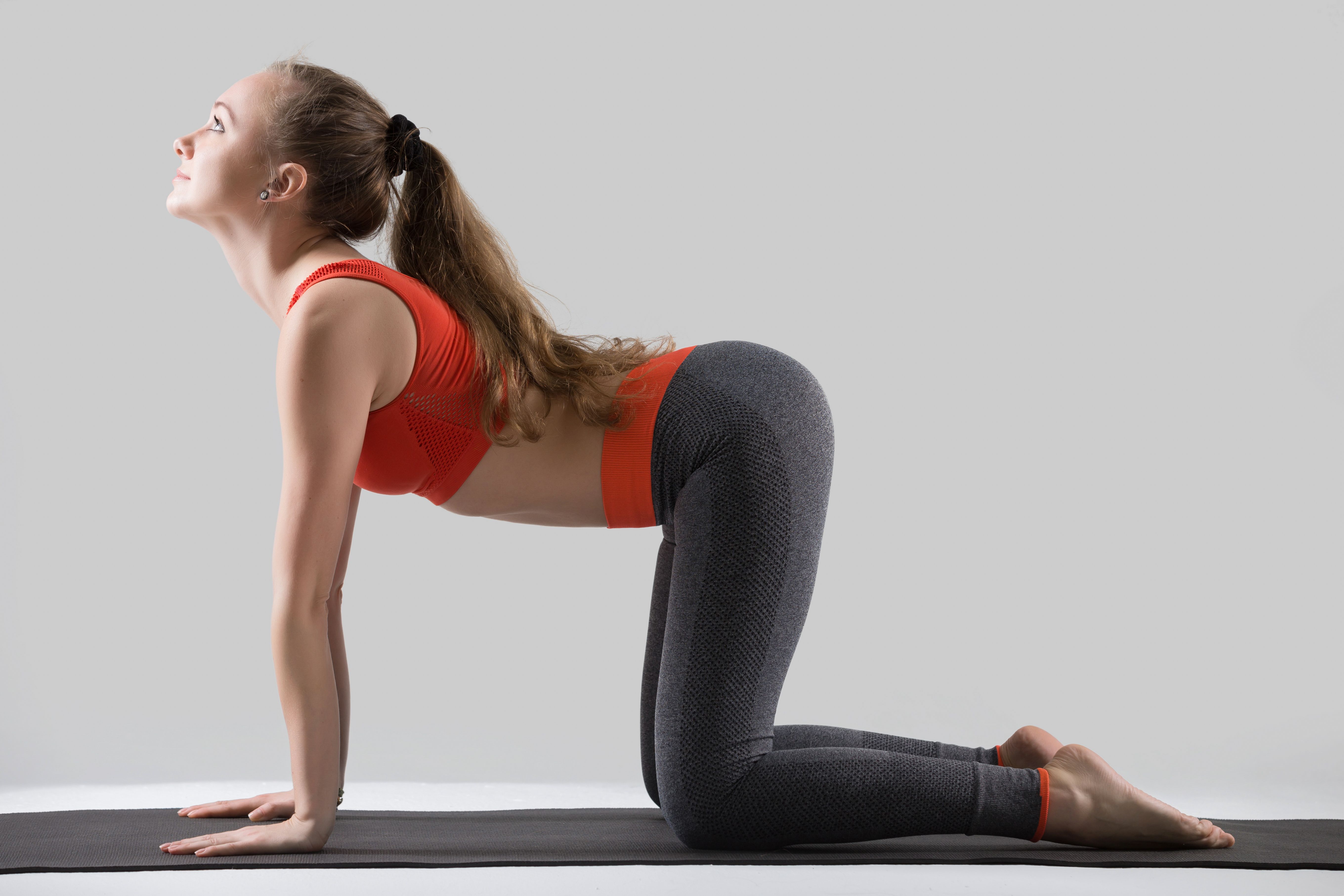
Inhale as you round your spine towards the yoga mat and gaze up at a 45-degree angle (where the wall and ceiling meet). Hold this pose here for a few seconds, and then again, allow your spine to return to a neutral stance.
3. Uttana Shishosana (Extended Puppy Pose) - This is a mini version of the Downward-Facing Dog posture. It’s effective in opening the chest, shoulders, spine, and upper back. Continuing from the Cat-Cow Pose, gently sit back on your shins and keep your arms flexing forward.

Ensure your upper body is engaged and bring your chest close to the ground. If you feel more flexible, try resting your chest on the ground to feel your shoulders deeply opening up.
Part 2: Step-by-Step Instructions to Perform Adho Mukha Svanasana
The following are steps to practice the Downward-Facing Dog Pose:
Step 1- Start from a tabletop position and place your hands, knees, and the tops of your feet flat on the mat.
Step 2- Slowly walk your hands to just ahead of your shoulders, keeping them as wide as the mat.
Step 3- Press your fingers into the mat, engaging your index fingers and thumbs by pressing them deeper into the mat.
Step 4- Inhale as you align your shoulders with straight arms and engage your core muscles.
Step 5- With an exhale, curl your toes under and lift your glutes up and back to form an inverted V. (If your hamstrings are hurting, try bending your knees).
Step 6- Press your heels onto the mat. Pull your traps and triceps toward your ears. Use your shoulders and palms to move the mat away from you.
Step 7- Hold this position for 5 to 10 full breaths. Release and relax by coming back down into the tabletop posture.
Breath Awareness:
Inhale: When you engage your core and upper body.
Exhale: When you are ready to lift your legs off your mat and flex in an inverted V.
Performance Duration for Beginners: Hold the Adho Mukha Svanasana for 30 to 60 seconds.
Performance Duration for Advanced: Hold the Adho Mukha Svanasana for 1 to 3 minutes.
Part 3: Things to Keep in Mind
These are some posture and alignment tips to keep in mind while performing Downward-Facing Dog, and will help you stay prevent injury:
Don’t lock your joints: This is the most common mistake that beginners make and can cause serious harm to your joint health, like severe joint pain or swelling. So, maintain a slight bend in your joints as you perform this pose.
Incorrect feet placement: Make sure that your feet are placed flat on the ground if you are holding this pose. This way, you can engage your hamstrings and quads more deeply.
Unable to hold the pose: If you feel shaky on all four limbs, try engaging your core muscles more deeply. If your core is not strong, try practicing a plank pose instead, or use a posture modification to build up your core strength.
Part 4: Relaxing Poses After Adho Mukha Svanasana
Here is the list of a few counter-poses to perform after Downward-Facing Dog:
1. Catur Svanasana (Dolphin Pose): From Downward-Facing Dog, bend your elbows and place your forearms on the yoga mat.

This pose will help you minimize the strain on your elbow and shoulder joints and give your lower body a deeper flex.
2. Balasana (Child's Pose): This versatile yoga asana works best as a deep chest opening pose like the Downward Dog Pose.
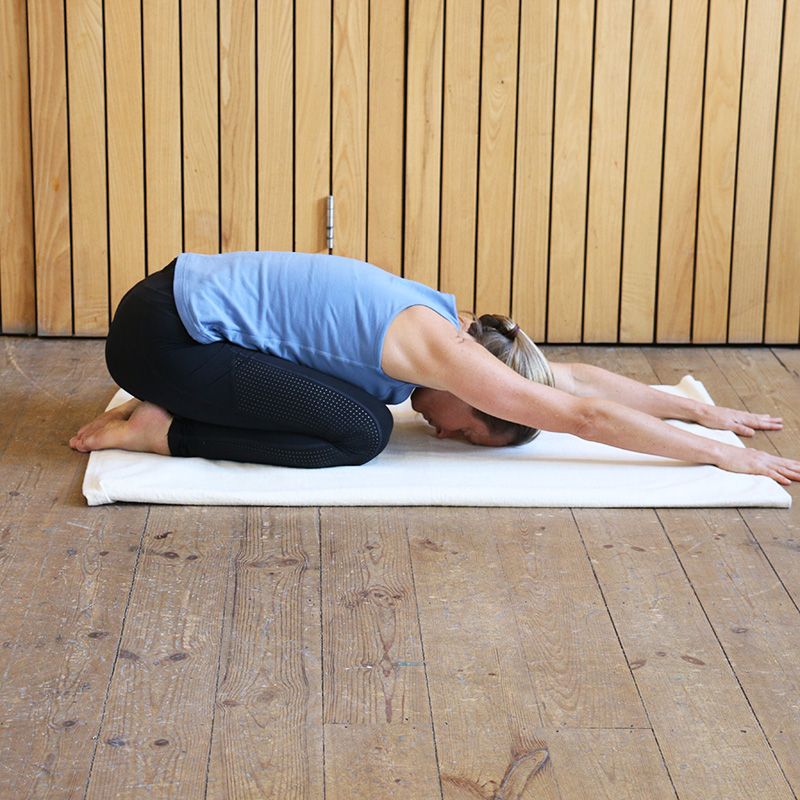
Simply sit onto your shins and heels, but make sure that your upper body is leaning forward, and your head is rested on the floor. Hold this for a few minutes to relax any tension in your spine, chest, and low back.
3. Prasarita Balasana (Extended Child Pose):
Continuing from Downward Dog, create a wide space between your legs and sit with your glutes between your legs.
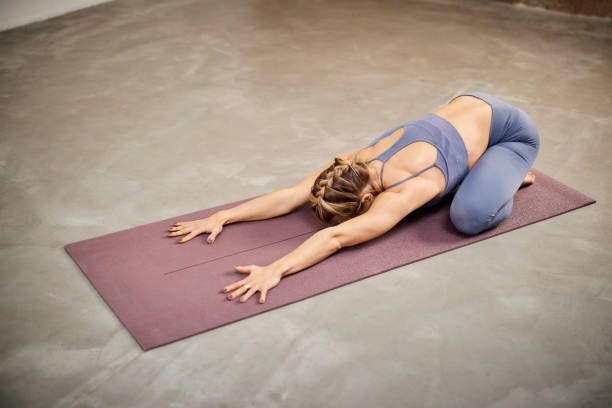
Rest your core, chest, and head on the mat, and try to take deep breaths as you hold this pose for a few minutes. This pose will help your spine and chest muscles return to their regular shape.
Adho Mukha Svanasana Variations to Consider
If you want to gently upgrade the amount of tension applied in the Downward Facing Dog posture, try the following posture variations:
1. Eka Pada Adho Mukha Svanasana (Single Leg Downward Facing Dog) - To challenge your core strength, get into Downward Dog and then lift one leg up towards the sky or ceiling.
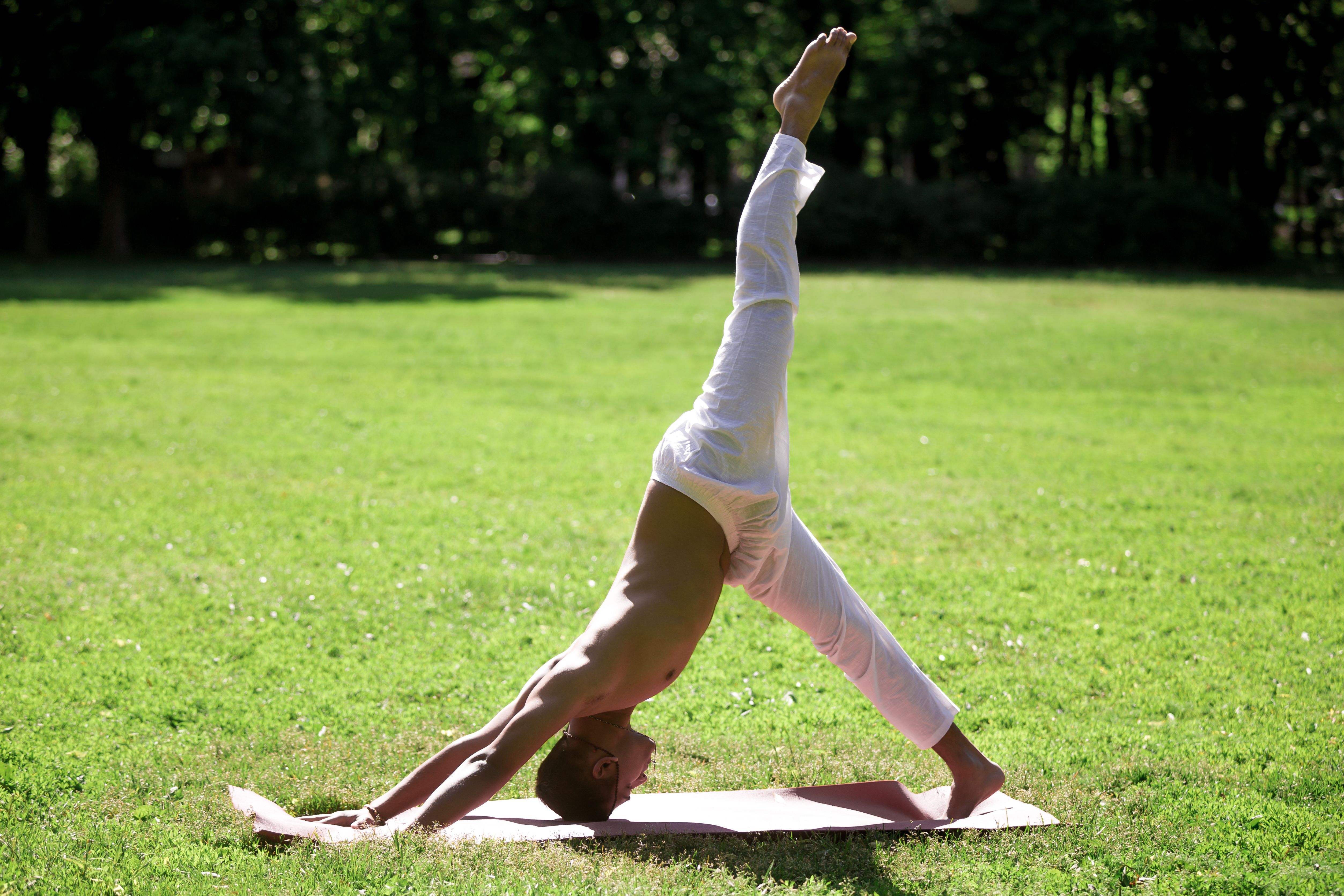
Make sure your core and quads are engaged and your hands are pressing firmly on the mat. Hold this variation on each leg for a couple of minutes.
2. Single-Leg Downward Dog to Tiger Curl Movement - This is a dynamic flow of three different yoga asanas, and it can help you melt lower abdomen fat.
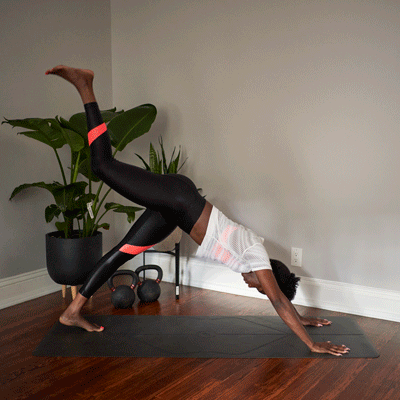
Simply start from Downward Dog, lift one leg up into a single-leg Downward Dog variation, and then bring your leg close to your chest. Repeat this on another side and perform 5-10 reps on each side.
3. Single-Leg Downward Dog Variation (Bend Leg Behind) - This pose will help you get into advanced yoga pose variations like Camatkarasana. All you need to do is get in the single-leg down dog variation and bend your straight leg at the end.
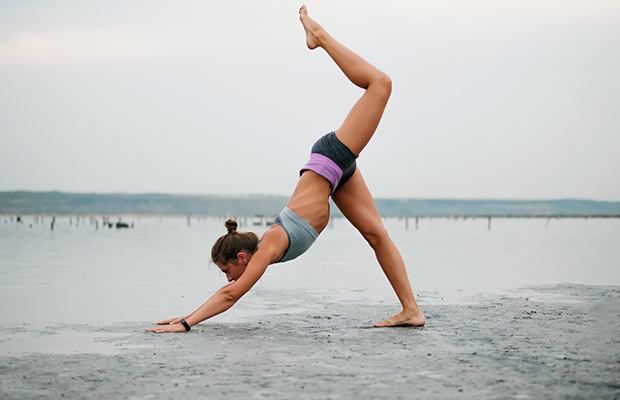
You can use this pose if you feel it’s challenging to balance on your straightened leg. Plus, it will improve mobility in your low back.

Enjoy a Free 1-on-1 Session with a Coach!
Receive personalized guidance tailored to your unique fitness goals, live with a dedicated coach—no credit card required.
Frequently Asked Questions about Adho Mukha Svanasana
The following are a few essential benefits of Adho Mukha Svanasana:
- Improves posture.
- Increases core strength.
- Alleviates lower back pain.
- Opens the chest and tailbone area.
- Strengthens the knee, ankle, and wrist joints.
- Stimulates hormone secretion and fights hormonal imbalance.
Adho is a Sanskrit word that means 'Down.' Adho in yoga denotes the direction toward the ground, like Adho Mukha Svanasana, which means - Downwards Facing Dog Pose.
Eka Pada Adho Mukha Svanasana is a posture variation for the primary Downward Dog practice. This variation increases flexion in the legs and upper body by raising one leg toward the ceiling.
This pose is an excellent way to deepen the stretch in your upper body, and it deeply activates your core, tailbone, and leg muscles.
Yes, beginners can perform Adho Mukha Svanasana. This pose is effortless to execute, all you need is strength in your wrists, core, and feet.
If beginners find this pose challenging, they can perform this pose with bent knees and elbows, or try adding more assistance with props.



.webp)
%20(7).jpg)




